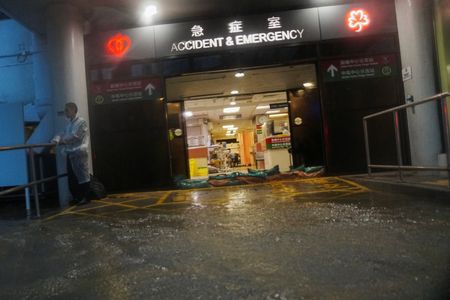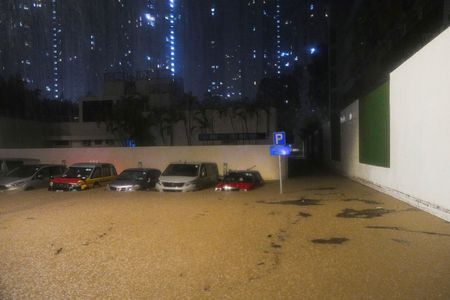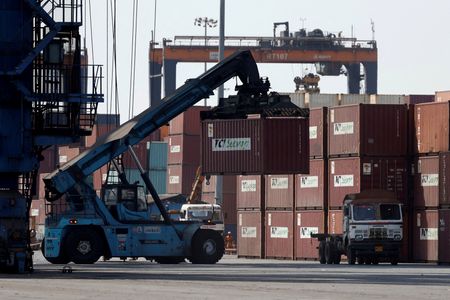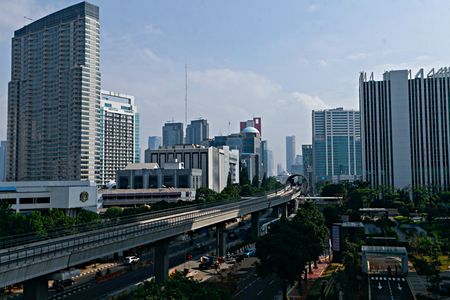By Joe Cash and Ryan Woo
BEIJING (Reuters) -Rescue crews raced on Wednesday to clear debris and flooded roads as southern China braced for more extreme rainfall and spreading infection after some of the worst downpours this century, brought by a peak in East Asian monsoon rains.
Forecasters warned of more thunderstorms after the century’s second-heaviest August rains pounded Guangzhou, the capital of Guangdong province, forcing its Baiyun airport, one of the world’s busiest, to cancel 363 flights and delay 311.
The day before, the skies above Hong Kong and the high-tech cities of China’s Pearl River Delta turned livid and dumped the heaviest August rainfall since 1884 on the Asian financial hub.
Rescue teams in Guangdong scrambled to open drains and pump water away from urban areas, state media said, as the intense rain set off mudslides and felled trees on highways, ripping up roads to expose cabling and other infrastructure.
Video images showed roads transformed into brown waterways, threatening to worsen a major outbreak of chikungunya, fuelled by mosquitoes thriving in stagnant flood water, which had been on a downtrend before the latest rains.
Guangdong had reported more than 7,000 of the virus infections earlier.
China has suffered weeks of atmospheric chaos since July, battered by heavier-than-usual downpours with the East Asian monsoon stalling over its north and south.
Weather experts link the shifting pattern to climate change, testing officials as flash floods displace thousands and threaten billions of dollars in economic losses.
On Tuesday, Beijing allocated more than 1 billion yuan ($139 million) in disaster relief for Guangdong and the northern province of Hebei, as well as the capital, Beijing, and the northern region of Inner Mongolia, state news agency Xinhua said, including subsidies for damage to grain-growing areas.
“The rains will drive up prices for fresh fruits and vegetables,” said Dan Wang, a China expert at Eurasia Group.
While some farmers might be able to exploit the situation to their benefit, agricultural losses would hit incomes as a whole, she added.
Cold chain storage providers could benefit, she said, while higher prices could sustain consumer prices, after the latest data showed the first rise in five months.
Even e-commerce may not be immune, as a landslide north of Guangzhou early on Wednesday hit ‘Taobao Village’, a community where many households run shops on China’s Alibaba platform, trapping 14 people, with half the number still missing.
Across the province, 16 rivers threaten to breach their banks, with water levels at two sites reaching their highest since 2017 and 2018.
But the worst may be yet to come, with two to three typhoons expected to strike in August, emergency management authorities said on Tuesday.
DISEASE OUTBREAK
The city of Foshan west of Guangzhou has been the epicentre of the province’s chikungunya outbreak, while at least a dozen more have reported infections, which typically cause fever and severe joint pain, though deaths are rare.
The next few weeks are especially daunting for disease prevention and control, say provincial authorities, after the flood season, worsened by typhoons and heavy rain, boosted mosquito activity.
Spread by the bite of infected Aedes mosquitoes, global infections of the disease number at least 240,000 this year.
But the disease and rainfall will have an uneven economic impact on China, thanks to their localised nature, said Chim Lee, a senior analyst at the Economist Intelligence Unit.
“In harder-hit areas like Guangdong, outdoor activity is discouraged, and many brick-and-mortar, consumer-facing businesses are seeing a drop in footfall,” he added.
“Industrial and commercial operations are also feeling the strain.”
($1=7.1834 yuan)
(Reporting by Joe Cash; Editing by Michael Perry and Clarence Fernandez)











